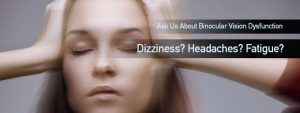Migraines impact the lives of over 1 in 8 of all people, including children.
A migraine is a neurological condition that causes intense pain in and around the head. Chronic migraines can disrupt your productivity and quality of life. But many times, migraines are linked to binocular vision dysfunction (BVD)— a condition that can be treated with the help of a neuro-optometrist.
Statistics of migraine prevalence
- Migraines are most common between the ages of 18 and 44
- 1 in 4 U.S. households has a family member that suffers from migraines
- 12% of the population, including children, suffers from migraines
- 18% of all women, 6% of all men, and 10% of all children experience migraines
Signs of a migraine
The primary sign of a migraine is an intense pain in at least one part of the head.
Migraines can present with a range of symptoms, including:
- Pulsing or throbbing in the head
- Light and sound sensitivity
- Dizziness
- Vomiting and nausea
- Sweating or chills
- Blurred vision
- Temporary vision loss
- Visual distortions, such as zig-zag lines
- Fatigue
- Loss of appetite
Some migraines present with an aura, or sensory, motor and speech disturbances.
SEE RELATED: What is Binocular Visual Dysfunction (BVD)?
If you or a loved one suffers from migraines, contact an eye doctor near you to rule out an eye condition, such as BVD.
What causes migraines?
Although the exact cause of migraines has yet to be discovered, researchers believe that there are several contributing factors, including:
- Genetic predisposition
- An imbalance in brain chemistry
- Certain medications
- Stress
- Excessive caffeine or alcohol
- Sensory stimuli, like flashes of light or strong odors
- Certain foods
- Dehydration
- Hormonal fluctuations
- Changes in sleep patterns
- Binocular vision dysfunction
What is binocular vision dysfunction (BVD)?
It is estimated that BVD impacts the lives of up to 1 in 12 people.
Binocular vision dysfunction (BVD) is defined as a horizontal or vertical misalignment of the eyes which disrupts the eyes’ ability to work together as a team.
In normal vision, the eyes work in coordination, sending identical images to the brain for interpretation and processing. The brain then fuses the two images together to produce a single image that you can see clearly.
When the eyes don’t work in coordination, each eye sends a different image to the brain, causing confusion within the visual system and resulting in double vision or other visual disturbances.
Many people with BVD experience physical, visual or emotional symptoms.
A migraine from BVD occurs when the muscles in the eyes are overly stressed from working hard to realign the eyes.
The symptoms of BVD can be debilitating and make it difficult to perform regular daily activities, such as driving and reading, and can also affect concentration and heighten anxiety.
Unfortunately, BVD is often overlooked or mistaken for other conditions, such as anxiety, agoraphobia, ADHD, reading and learning disabilities, spinal or neck misalignment, chronic fatigue syndrome, temporomandibular joint disorders and Meniere’s disease.
It is therefore essential to see an eye doctor who has experience with migraines and BVD, for a proper diagnosis.
How is BVD treated?
The symptoms of BVD are often relieved with prism lenses.
Prism lenses refocus light to compensate for the eye’s misalignment. In many cases, immediate relief is felt as soon as the prism lenses are introduced.
Since migraines from BVD can be effectively treated, a comprehensive visual evaluation is crucial, and can be life altering.
LEARN MORE: Guide to Binocular Visual Dysfunction (BVD)
If you or a loved one suffers from migraines, schedule a comprehensive vision evaluation with an eye doctor near you.
Migraines can be caused by a range of conditions, including an eye condition known as BVD.
Fortunately, BVD can be effectively treated by eye doctors so you can find the relief you are searching for.









